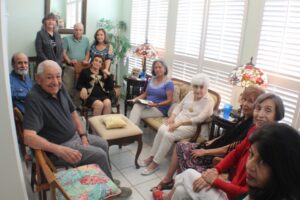“When we arrived, the lakes that exist now didn’t exist. I remember the beautiful inauguration of the Lakes Woodlands lake. All the guests were on the floor of the lake, obviously without water. Also, at that time, we created two very valuable groups: the International Friends and another one for Hispanics, with the purpose of welcoming them and building bonds of friendship based on respect for each culture, race, and religion.”
It has been more than 40 years since Alma Ledwell arrived in The Woodlands, along with her husband Thomas Frank Ledwell. Their two children, Frank and Vincent, were born here and continue to live in the city, and now Alma enjoys spending time with her grandchildren. Three generations continue together in this beautiful city. This is their story:
“We arrived in 1977 because my husband began working for Mitchell Energy and Development Corporation at the invitation of Mr. Charles Lively, who was the head of the Land Acquisition Department and retired shortly after. My husband was appointed head of the Land Acquisition Department. His job was to acquire land to expand The Woodlands and continue its development and growth.
At that time, Panther Creek was starting to take shape, and my husband was responsible for continuing the work of adding Indian Springs, Sterling Ridge, Carlton Woods, and others—projects that led to a close friendship with George Mitchell, Ed Lee, and Roger Gálatas, among other colleagues.
Over time, Mitchell Energy and Development Corporation was sold in 1997 to Morgan Stanley and Crescent Real Estate Equities, which eventually sold it to other corporations. The current owners are Howard Hughes Corporation, since 2011.”
When we arrived in The Woodlands, the population was 16,000, there were no large lakes like we see today, and The Woodlands Community Hospital (1985) had 40 beds. There was also the Woodlands Athletic Center with an Olympic-sized pool, and the Woodlands Country Club (1978) which had exclusive restaurants like The Glass Menagerie and the one at The Woodlands Inn hotel.
The Grogans Mill Village Center (which still exists today) had offices and businesses like the bookstore called Just Books, a post office, the newspaper “The Woodlands Villager,” and it connected to the Country Club, which led to a Cunningham’s pharmacy; the ice skating rink, the music institute run by Mrs. Estes, and the Spanish institute run by Mrs. Mariluz Gutiérrez and Mrs. Carmen Teuscher, among other places that have since disappeared.
And what was life like in the community? Where did people go to socialize and participate in activities?
Everything was so different from what we see today.
Back then, The Interfaith Center was the heart and gathering place for all the religious denominations in the community. For example, I belong to Sts. Simon and Jude Catholic Parish, and I remember going to propose to Monsignor Charles Domec the idea of creating an organization to welcome foreigners and share cultures and friendship (I am Mexican, and I felt the desire to meet more Hispanic people and also others from different countries).
There was also the need to learn English, and we added crafts to the mix. Monsignor Father Domec invited us to propose these initiatives at the Interfaith Center, which were approved, and from there, we organized International Women. However, we had to change the name to International Friends of The Woodlands because since then, and to this day, we have both men and women from various countries, denominations, and nonprofit backgrounds.
Almost simultaneously, the Hispanic Group was created with the goal of preserving cultures and helping in various ways, such as teaching Spanish and English, as it was a great challenge for Hispanic parents to fully integrate into The Woodlands community.
I feel very privileged to witness the growth that this beautiful community of The Woodlands has experienced.
How has The Woodlands changed since then? What is different now?
It’s amazing to see how much it has grown. In those early years, our children studied here, graduated, and many of them returned to live in the community. It’s beautiful to see how The Woodlands has prospered and embraced people from all over the world and from other states in the U.S. However, with all this growth, we have also lost a bit of that small-town spirit. Now we have a vibrant city, with a lot of traffic and a large number of services and restaurants, something that didn’t exist before.
I remember the little paths we used to call “caminillos,” where trees were marked so people could learn about the local flora. I don’t see those signs anymore, although maybe some still exist. It’s been a fascinating journey to watch how The Woodlands has transformed, and while we’ve gained a lot, we’ve also lost some of the simplicity that made this place so special.
Every corner of The Woodlands tells a story, and I feel fortunate to have been part of its growth from its early days to what it is now. It’s a place full of memories, learning, and community.










